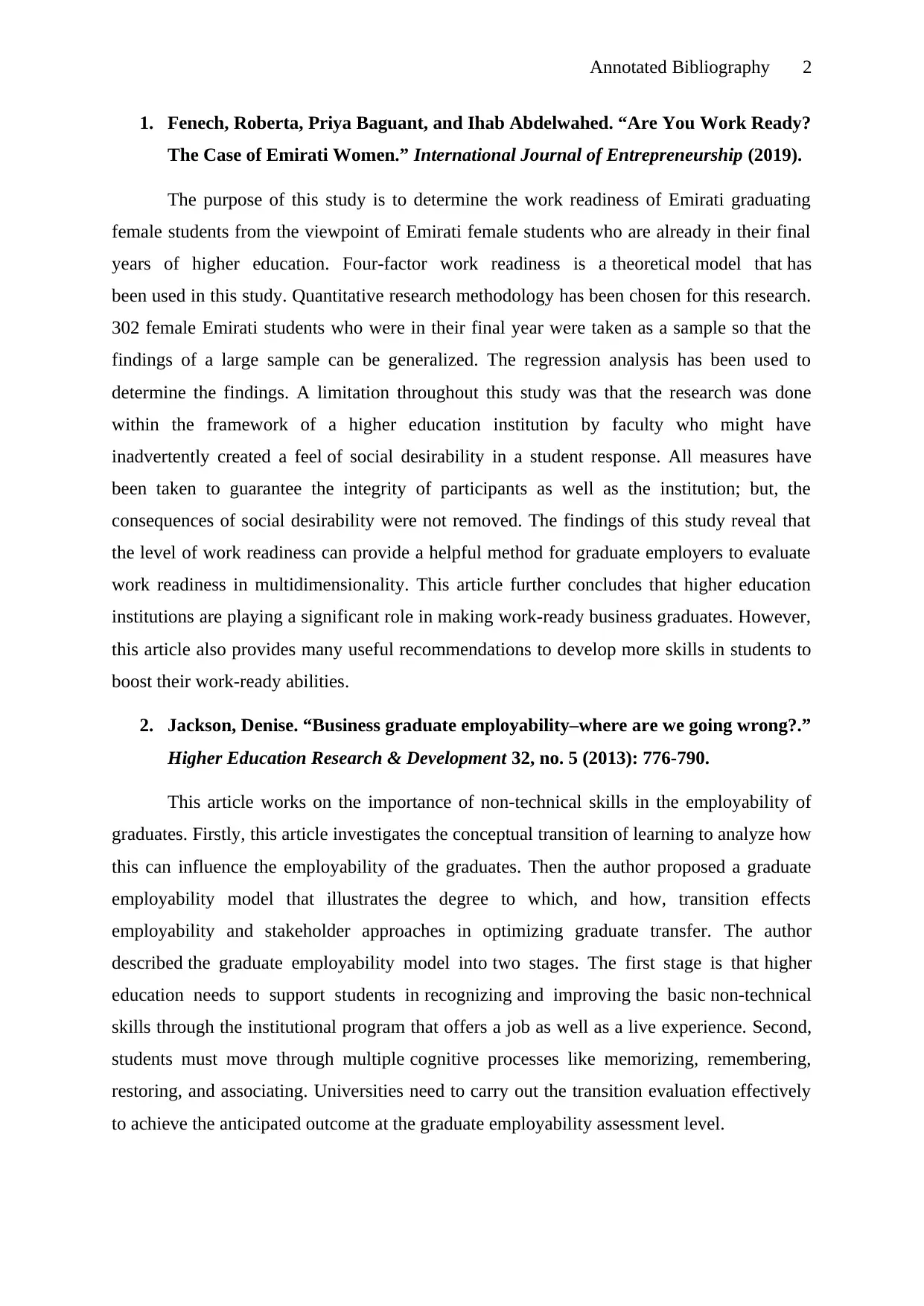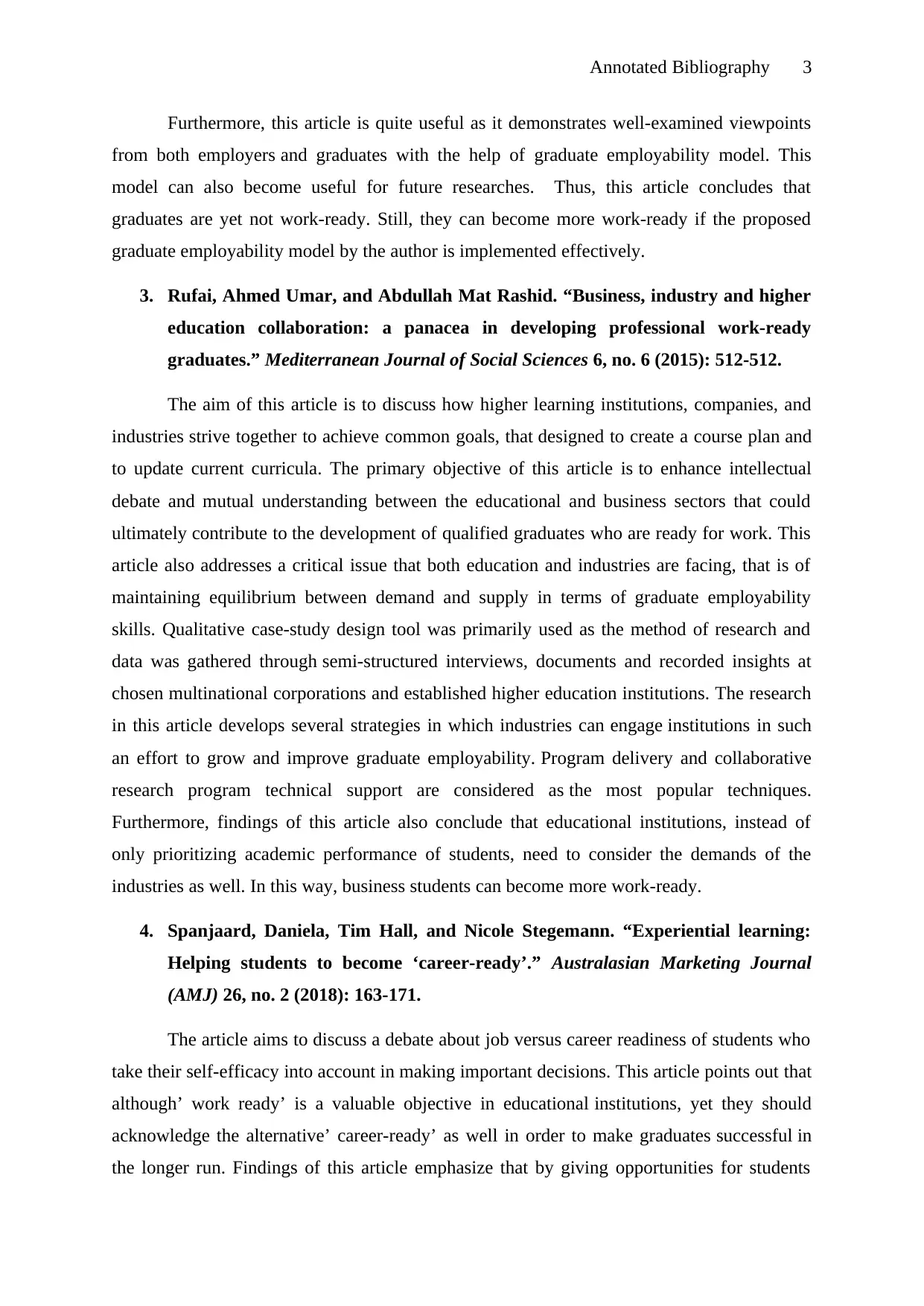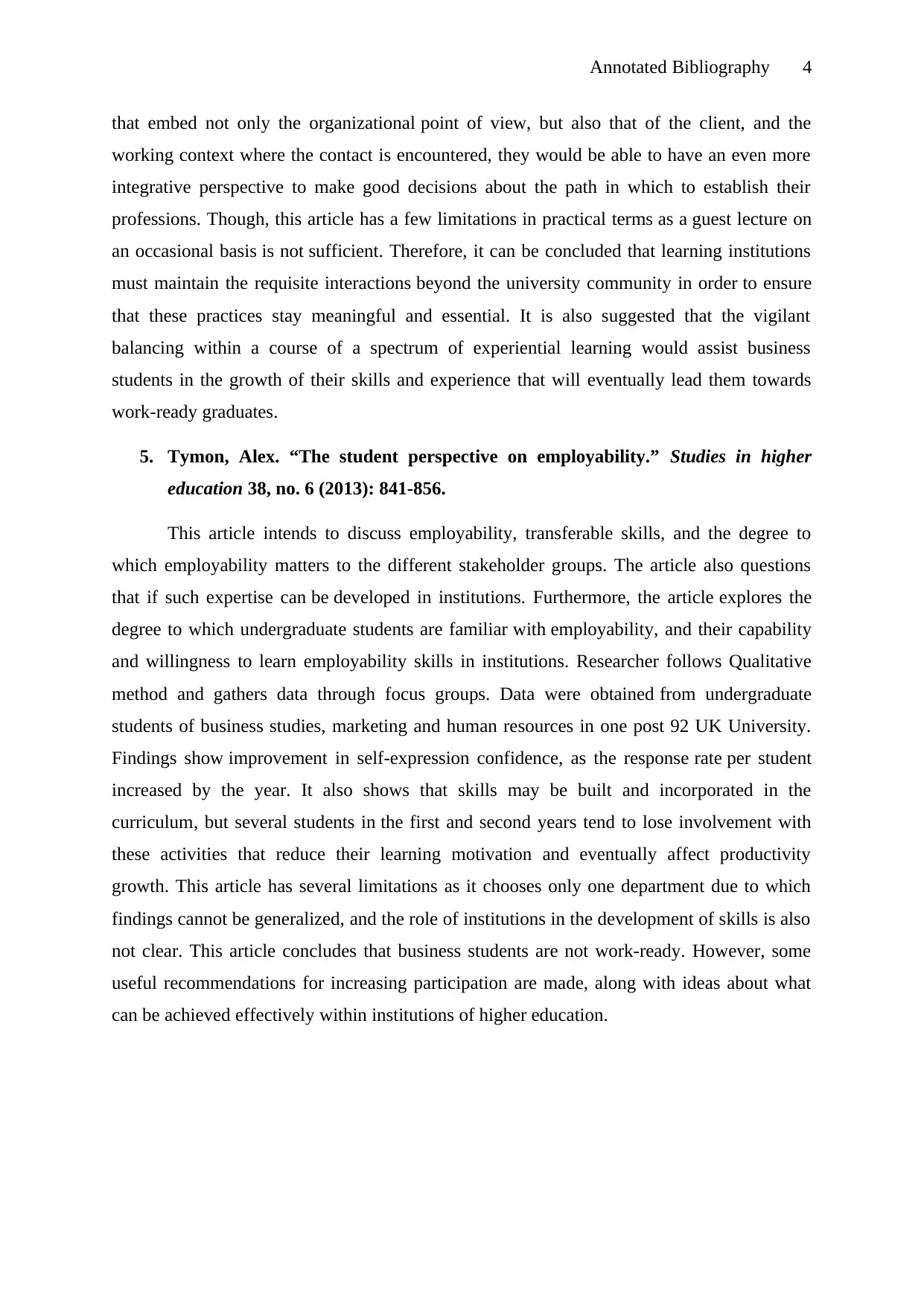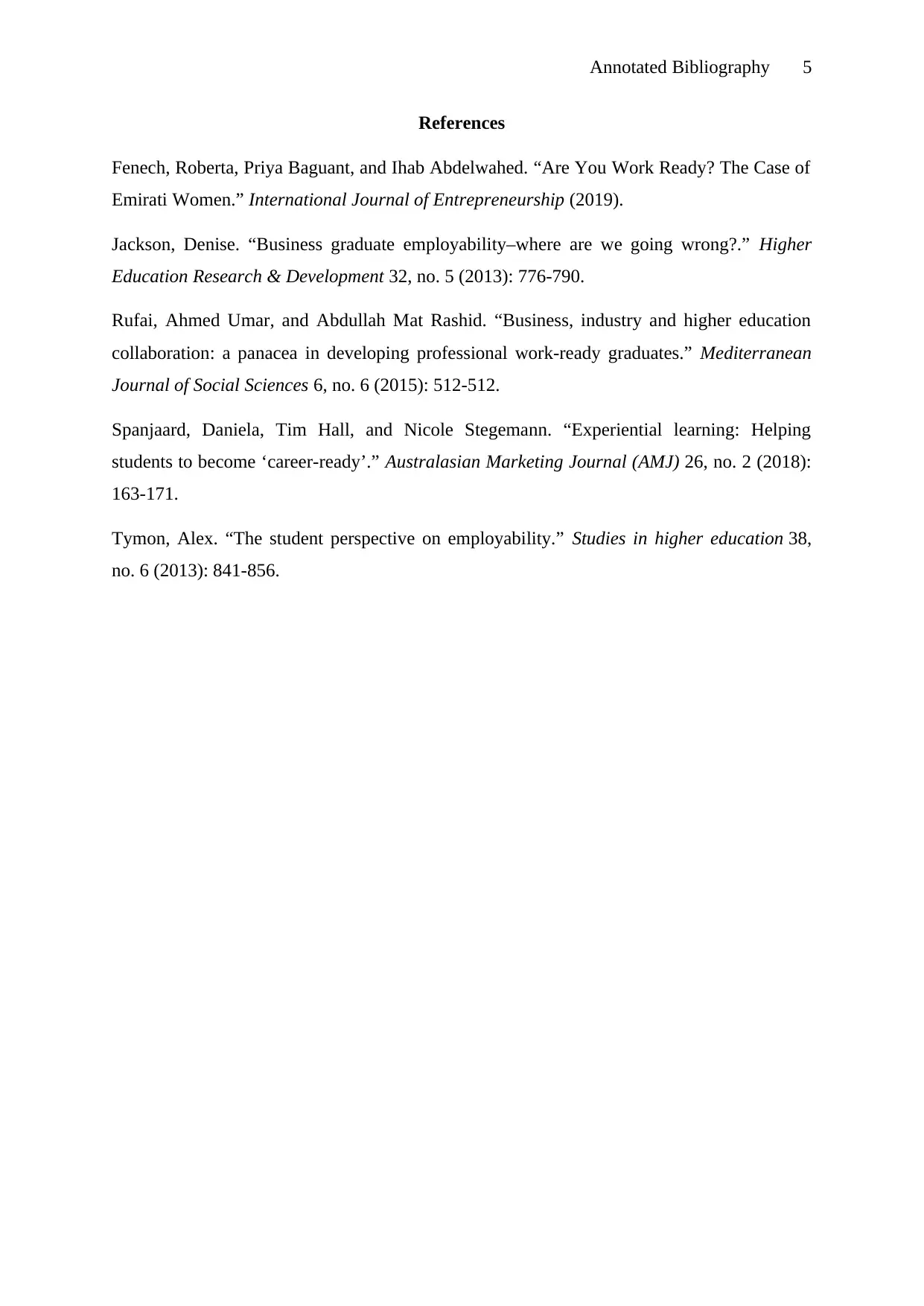Annotated Bibliography: Business Research and Work Readiness Analysis
VerifiedAdded on 2022/08/24
|5
|1474
|39
Annotated Bibliography
AI Summary
This annotated bibliography examines five scholarly articles related to business research, graduate employability, and work readiness. Fenech et al. (2019) investigate the work readiness of Emirati female graduates, utilizing a quantitative methodology and highlighting the role of higher education. Jackson (2013) emphasizes the importance of non-technical skills and proposes a graduate employability model. Rufai and Rashid (2015) discuss the collaboration between higher education institutions and industries to develop work-ready graduates. Spanjaard et al. (2018) debate job versus career readiness, advocating for experiential learning. Finally, Tymon (2013) explores the student perspective on employability, identifying limitations and offering recommendations for improving skill development within higher education. The bibliography provides a critical overview of each source, summarizing their aims, methodologies, findings, and limitations, offering a comprehensive understanding of the current research landscape and its implications for business education and graduate preparedness.

Annotated Bibliography 1
ANNOTATED BIBLIOGRAPHY
Subject: Management
Title: Understanding Business Research
Word Count=1000
ANNOTATED BIBLIOGRAPHY
Subject: Management
Title: Understanding Business Research
Word Count=1000
Paraphrase This Document
Need a fresh take? Get an instant paraphrase of this document with our AI Paraphraser

Annotated Bibliography 2
1. Fenech, Roberta, Priya Baguant, and Ihab Abdelwahed. “Are You Work Ready?
The Case of Emirati Women.” International Journal of Entrepreneurship (2019).
The purpose of this study is to determine the work readiness of Emirati graduating
female students from the viewpoint of Emirati female students who are already in their final
years of higher education. Four-factor work readiness is a theoretical model that has
been used in this study. Quantitative research methodology has been chosen for this research.
302 female Emirati students who were in their final year were taken as a sample so that the
findings of a large sample can be generalized. The regression analysis has been used to
determine the findings. A limitation throughout this study was that the research was done
within the framework of a higher education institution by faculty who might have
inadvertently created a feel of social desirability in a student response. All measures have
been taken to guarantee the integrity of participants as well as the institution; but, the
consequences of social desirability were not removed. The findings of this study reveal that
the level of work readiness can provide a helpful method for graduate employers to evaluate
work readiness in multidimensionality. This article further concludes that higher education
institutions are playing a significant role in making work-ready business graduates. However,
this article also provides many useful recommendations to develop more skills in students to
boost their work-ready abilities.
2. Jackson, Denise. “Business graduate employability–where are we going wrong?.”
Higher Education Research & Development 32, no. 5 (2013): 776-790.
This article works on the importance of non-technical skills in the employability of
graduates. Firstly, this article investigates the conceptual transition of learning to analyze how
this can influence the employability of the graduates. Then the author proposed a graduate
employability model that illustrates the degree to which, and how, transition effects
employability and stakeholder approaches in optimizing graduate transfer. The author
described the graduate employability model into two stages. The first stage is that higher
education needs to support students in recognizing and improving the basic non-technical
skills through the institutional program that offers a job as well as a live experience. Second,
students must move through multiple cognitive processes like memorizing, remembering,
restoring, and associating. Universities need to carry out the transition evaluation effectively
to achieve the anticipated outcome at the graduate employability assessment level.
1. Fenech, Roberta, Priya Baguant, and Ihab Abdelwahed. “Are You Work Ready?
The Case of Emirati Women.” International Journal of Entrepreneurship (2019).
The purpose of this study is to determine the work readiness of Emirati graduating
female students from the viewpoint of Emirati female students who are already in their final
years of higher education. Four-factor work readiness is a theoretical model that has
been used in this study. Quantitative research methodology has been chosen for this research.
302 female Emirati students who were in their final year were taken as a sample so that the
findings of a large sample can be generalized. The regression analysis has been used to
determine the findings. A limitation throughout this study was that the research was done
within the framework of a higher education institution by faculty who might have
inadvertently created a feel of social desirability in a student response. All measures have
been taken to guarantee the integrity of participants as well as the institution; but, the
consequences of social desirability were not removed. The findings of this study reveal that
the level of work readiness can provide a helpful method for graduate employers to evaluate
work readiness in multidimensionality. This article further concludes that higher education
institutions are playing a significant role in making work-ready business graduates. However,
this article also provides many useful recommendations to develop more skills in students to
boost their work-ready abilities.
2. Jackson, Denise. “Business graduate employability–where are we going wrong?.”
Higher Education Research & Development 32, no. 5 (2013): 776-790.
This article works on the importance of non-technical skills in the employability of
graduates. Firstly, this article investigates the conceptual transition of learning to analyze how
this can influence the employability of the graduates. Then the author proposed a graduate
employability model that illustrates the degree to which, and how, transition effects
employability and stakeholder approaches in optimizing graduate transfer. The author
described the graduate employability model into two stages. The first stage is that higher
education needs to support students in recognizing and improving the basic non-technical
skills through the institutional program that offers a job as well as a live experience. Second,
students must move through multiple cognitive processes like memorizing, remembering,
restoring, and associating. Universities need to carry out the transition evaluation effectively
to achieve the anticipated outcome at the graduate employability assessment level.

Annotated Bibliography 3
Furthermore, this article is quite useful as it demonstrates well-examined viewpoints
from both employers and graduates with the help of graduate employability model. This
model can also become useful for future researches. Thus, this article concludes that
graduates are yet not work-ready. Still, they can become more work-ready if the proposed
graduate employability model by the author is implemented effectively.
3. Rufai, Ahmed Umar, and Abdullah Mat Rashid. “Business, industry and higher
education collaboration: a panacea in developing professional work-ready
graduates.” Mediterranean Journal of Social Sciences 6, no. 6 (2015): 512-512.
The aim of this article is to discuss how higher learning institutions, companies, and
industries strive together to achieve common goals, that designed to create a course plan and
to update current curricula. The primary objective of this article is to enhance intellectual
debate and mutual understanding between the educational and business sectors that could
ultimately contribute to the development of qualified graduates who are ready for work. This
article also addresses a critical issue that both education and industries are facing, that is of
maintaining equilibrium between demand and supply in terms of graduate employability
skills. Qualitative case-study design tool was primarily used as the method of research and
data was gathered through semi-structured interviews, documents and recorded insights at
chosen multinational corporations and established higher education institutions. The research
in this article develops several strategies in which industries can engage institutions in such
an effort to grow and improve graduate employability. Program delivery and collaborative
research program technical support are considered as the most popular techniques.
Furthermore, findings of this article also conclude that educational institutions, instead of
only prioritizing academic performance of students, need to consider the demands of the
industries as well. In this way, business students can become more work-ready.
4. Spanjaard, Daniela, Tim Hall, and Nicole Stegemann. “Experiential learning:
Helping students to become ‘career-ready’.” Australasian Marketing Journal
(AMJ) 26, no. 2 (2018): 163-171.
The article aims to discuss a debate about job versus career readiness of students who
take their self-efficacy into account in making important decisions. This article points out that
although’ work ready’ is a valuable objective in educational institutions, yet they should
acknowledge the alternative’ career-ready’ as well in order to make graduates successful in
the longer run. Findings of this article emphasize that by giving opportunities for students
Furthermore, this article is quite useful as it demonstrates well-examined viewpoints
from both employers and graduates with the help of graduate employability model. This
model can also become useful for future researches. Thus, this article concludes that
graduates are yet not work-ready. Still, they can become more work-ready if the proposed
graduate employability model by the author is implemented effectively.
3. Rufai, Ahmed Umar, and Abdullah Mat Rashid. “Business, industry and higher
education collaboration: a panacea in developing professional work-ready
graduates.” Mediterranean Journal of Social Sciences 6, no. 6 (2015): 512-512.
The aim of this article is to discuss how higher learning institutions, companies, and
industries strive together to achieve common goals, that designed to create a course plan and
to update current curricula. The primary objective of this article is to enhance intellectual
debate and mutual understanding between the educational and business sectors that could
ultimately contribute to the development of qualified graduates who are ready for work. This
article also addresses a critical issue that both education and industries are facing, that is of
maintaining equilibrium between demand and supply in terms of graduate employability
skills. Qualitative case-study design tool was primarily used as the method of research and
data was gathered through semi-structured interviews, documents and recorded insights at
chosen multinational corporations and established higher education institutions. The research
in this article develops several strategies in which industries can engage institutions in such
an effort to grow and improve graduate employability. Program delivery and collaborative
research program technical support are considered as the most popular techniques.
Furthermore, findings of this article also conclude that educational institutions, instead of
only prioritizing academic performance of students, need to consider the demands of the
industries as well. In this way, business students can become more work-ready.
4. Spanjaard, Daniela, Tim Hall, and Nicole Stegemann. “Experiential learning:
Helping students to become ‘career-ready’.” Australasian Marketing Journal
(AMJ) 26, no. 2 (2018): 163-171.
The article aims to discuss a debate about job versus career readiness of students who
take their self-efficacy into account in making important decisions. This article points out that
although’ work ready’ is a valuable objective in educational institutions, yet they should
acknowledge the alternative’ career-ready’ as well in order to make graduates successful in
the longer run. Findings of this article emphasize that by giving opportunities for students
⊘ This is a preview!⊘
Do you want full access?
Subscribe today to unlock all pages.

Trusted by 1+ million students worldwide

Annotated Bibliography 4
that embed not only the organizational point of view, but also that of the client, and the
working context where the contact is encountered, they would be able to have an even more
integrative perspective to make good decisions about the path in which to establish their
professions. Though, this article has a few limitations in practical terms as a guest lecture on
an occasional basis is not sufficient. Therefore, it can be concluded that learning institutions
must maintain the requisite interactions beyond the university community in order to ensure
that these practices stay meaningful and essential. It is also suggested that the vigilant
balancing within a course of a spectrum of experiential learning would assist business
students in the growth of their skills and experience that will eventually lead them towards
work-ready graduates.
5. Tymon, Alex. “The student perspective on employability.” Studies in higher
education 38, no. 6 (2013): 841-856.
This article intends to discuss employability, transferable skills, and the degree to
which employability matters to the different stakeholder groups. The article also questions
that if such expertise can be developed in institutions. Furthermore, the article explores the
degree to which undergraduate students are familiar with employability, and their capability
and willingness to learn employability skills in institutions. Researcher follows Qualitative
method and gathers data through focus groups. Data were obtained from undergraduate
students of business studies, marketing and human resources in one post 92 UK University.
Findings show improvement in self-expression confidence, as the response rate per student
increased by the year. It also shows that skills may be built and incorporated in the
curriculum, but several students in the first and second years tend to lose involvement with
these activities that reduce their learning motivation and eventually affect productivity
growth. This article has several limitations as it chooses only one department due to which
findings cannot be generalized, and the role of institutions in the development of skills is also
not clear. This article concludes that business students are not work-ready. However, some
useful recommendations for increasing participation are made, along with ideas about what
can be achieved effectively within institutions of higher education.
that embed not only the organizational point of view, but also that of the client, and the
working context where the contact is encountered, they would be able to have an even more
integrative perspective to make good decisions about the path in which to establish their
professions. Though, this article has a few limitations in practical terms as a guest lecture on
an occasional basis is not sufficient. Therefore, it can be concluded that learning institutions
must maintain the requisite interactions beyond the university community in order to ensure
that these practices stay meaningful and essential. It is also suggested that the vigilant
balancing within a course of a spectrum of experiential learning would assist business
students in the growth of their skills and experience that will eventually lead them towards
work-ready graduates.
5. Tymon, Alex. “The student perspective on employability.” Studies in higher
education 38, no. 6 (2013): 841-856.
This article intends to discuss employability, transferable skills, and the degree to
which employability matters to the different stakeholder groups. The article also questions
that if such expertise can be developed in institutions. Furthermore, the article explores the
degree to which undergraduate students are familiar with employability, and their capability
and willingness to learn employability skills in institutions. Researcher follows Qualitative
method and gathers data through focus groups. Data were obtained from undergraduate
students of business studies, marketing and human resources in one post 92 UK University.
Findings show improvement in self-expression confidence, as the response rate per student
increased by the year. It also shows that skills may be built and incorporated in the
curriculum, but several students in the first and second years tend to lose involvement with
these activities that reduce their learning motivation and eventually affect productivity
growth. This article has several limitations as it chooses only one department due to which
findings cannot be generalized, and the role of institutions in the development of skills is also
not clear. This article concludes that business students are not work-ready. However, some
useful recommendations for increasing participation are made, along with ideas about what
can be achieved effectively within institutions of higher education.
Paraphrase This Document
Need a fresh take? Get an instant paraphrase of this document with our AI Paraphraser

Annotated Bibliography 5
References
Fenech, Roberta, Priya Baguant, and Ihab Abdelwahed. “Are You Work Ready? The Case of
Emirati Women.” International Journal of Entrepreneurship (2019).
Jackson, Denise. “Business graduate employability–where are we going wrong?.” Higher
Education Research & Development 32, no. 5 (2013): 776-790.
Rufai, Ahmed Umar, and Abdullah Mat Rashid. “Business, industry and higher education
collaboration: a panacea in developing professional work-ready graduates.” Mediterranean
Journal of Social Sciences 6, no. 6 (2015): 512-512.
Spanjaard, Daniela, Tim Hall, and Nicole Stegemann. “Experiential learning: Helping
students to become ‘career-ready’.” Australasian Marketing Journal (AMJ) 26, no. 2 (2018):
163-171.
Tymon, Alex. “The student perspective on employability.” Studies in higher education 38,
no. 6 (2013): 841-856.
References
Fenech, Roberta, Priya Baguant, and Ihab Abdelwahed. “Are You Work Ready? The Case of
Emirati Women.” International Journal of Entrepreneurship (2019).
Jackson, Denise. “Business graduate employability–where are we going wrong?.” Higher
Education Research & Development 32, no. 5 (2013): 776-790.
Rufai, Ahmed Umar, and Abdullah Mat Rashid. “Business, industry and higher education
collaboration: a panacea in developing professional work-ready graduates.” Mediterranean
Journal of Social Sciences 6, no. 6 (2015): 512-512.
Spanjaard, Daniela, Tim Hall, and Nicole Stegemann. “Experiential learning: Helping
students to become ‘career-ready’.” Australasian Marketing Journal (AMJ) 26, no. 2 (2018):
163-171.
Tymon, Alex. “The student perspective on employability.” Studies in higher education 38,
no. 6 (2013): 841-856.
1 out of 5
Related Documents
Your All-in-One AI-Powered Toolkit for Academic Success.
+13062052269
info@desklib.com
Available 24*7 on WhatsApp / Email
![[object Object]](/_next/static/media/star-bottom.7253800d.svg)
Unlock your academic potential
Copyright © 2020–2025 A2Z Services. All Rights Reserved. Developed and managed by ZUCOL.





